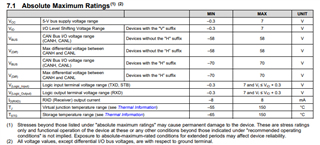Hello,
I am implementing a circuit based on this. For most of our products we have to survive short to 16V and short to GND.
Will this circuit support/survive those cases? Thanks!
Adam
This thread has been locked.
If you have a related question, please click the "Ask a related question" button in the top right corner. The newly created question will be automatically linked to this question.
Hello,
I am implementing a circuit based on this. For most of our products we have to survive short to 16V and short to GND.
Will this circuit support/survive those cases? Thanks!
Adam
Hi Adam,
I am going to add Eric Schott to the thread incase he has any more familiarity with the reference board. I am not sure if all the components can survive a 16V short to GND but the TCAN1042 has a bus fault tolerance of at least +/- 58V. There are some versions that have an even higher bus fault tolerance.
However this is only for the differential voltage on the CANH and CANL pins. The rest of the pins have absolute maximum ratings :

Exceeding any of these ratings could lead to permanent damage to the device. Shorting 16V to GND would damage this device since the minimum voltage allowed on the VCC and VIO pins is -0.3V. However the CAN bus can survive a temporary fault of up to +/- 58V.
Best,
Chris
Hi Adam,
To add a bit to Chris's reply, the transceiver itself will have no trouble with a 16V short on the CAN bus, as it is rated to much higher levels. The survivability of the selectable termination circuit will depend on how it is implemented.
The photorely in this reference design is specified to withstand 60V across its output state while off, meaning it will also be quite tolerant to a 16V short. While the relay is on, the max current of 100mA will also be sufficient if enough series resistance is used in conjunction with its on-state resistance. If the short is only momentary, typical termination values may be used as the allowable peak pulse current is greater.
It is harder to evaluate the FET based solution as there are more ways to go about isolating the gate voltage, so I will simplify my response by recommending the photorelay solution for best system fault-tolerance.
Let us know if you have any more questions.
Regards,
Eric Schott